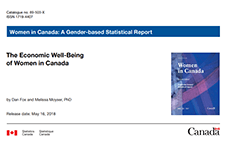Since the mid-1990s, Statistics Canada has been producing several time series to gauge the dynamics of low income using data from the Survey of Labour and Income Dynamics (SLID). These time series contain information on the entry, exit, and persistence of low income for several groups of individuals at different levels of geography, providing useful information for debates on poverty-alleviation polices. With the discontinuation of the longitudinal portion of the SLID, statistics on low-income dynamics will no longer be available after reference year 2010. This paper’s main objective is to see if it is feasible to fill this data gap by constructing statistics on low-income dynamics using data from the Longitudinal Administrative Databank (LAD). In particular, we attempt to see if the same dynamic low-income statistics can be obtained when the same methodology of low-income measure is applied to the LAD and the SLID.
The Economic Well-Being of Women in Canada



